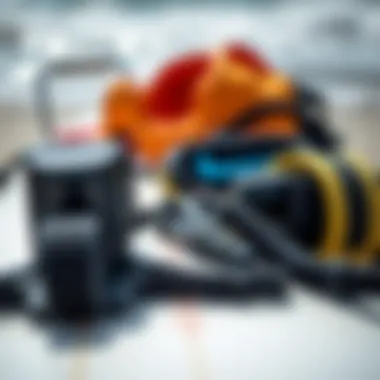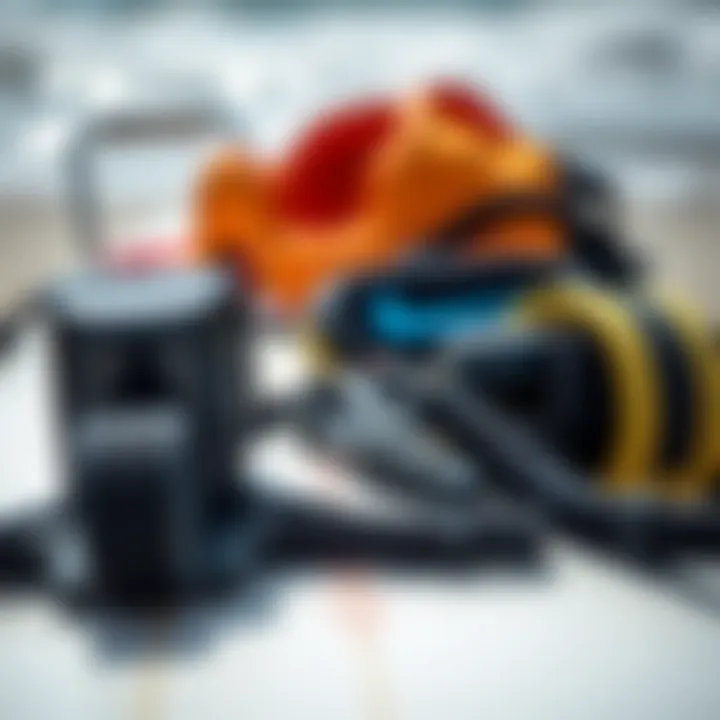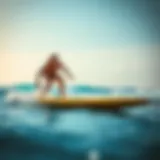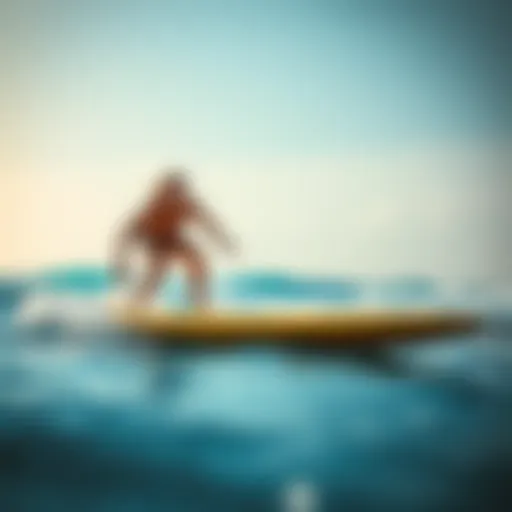Your First Surf Lesson: A Complete Guide


Intro
Stepping onto the sands of your first surf lesson often feels like standing at the edge of a great adventure. The salty air kisses your skin, and the rhythmic crash of waves beckons you closer. This guide serves as a roadmap for navigating this exhilarating initiation into the surfing world, where every wave brings new challenges and triumphs.
The experience of learning to surf is not just about balancing on a board; it dives into the essence of a culture steeped in camaraderie, respect for nature, and the sheer joy of riding the waves. Understanding this background can greatly enhance your appreciation of the sport and enrich your learning journey. What you’ll discover here is not just the nuts and bolts of surfing; you’ll find the heart of it as well.
Catching a wave might seem insurmountable at first, but with the right preparation and mindset, it turns into a memorable escapade. From selecting the right lesson to mastering essential techniques, we’ll break it all down. This is your invitation to embark on an adventure, one that opens up not only a new skill but also a community and lifestyle that thrives on connection and challenge. Let’s dive in.
Understanding Surf Culture
Embarking on your journey into surfing is about more than just riding waves; it’s about connecting with a vibrant and enduring culture. Understanding surf culture is pivotal as it immerses newcomers in the values and traditions that define this captivating sport. Identifying these components not only enhances the surfing experience but fosters respect and appreciation for the community surrounding it.
Historical Context of Surfing
The roots of surfing trace back to ancient Polynesian culture, where it was more than a pastime; it was a way of life deeply embedded in tradition. Surfing was practiced as early as the 12th century in Hawaii, where it was known as "he‘e nalu." Ancient Hawaiians shaped wooden boards that reflected their social status, with kings often utilizing longboards made from prized trees. In this regard, surfing was both an exhilarating sport and a cultural expression.
By the early 20th century, surfing had attracted international attention, chiefly through the efforts of figures like Duke Kahanamoku, a Hawaiian surfer and Olympic swimmer. His travels helped popularize surfing on the mainland of the United States and beyond, establishing the sport as a staple of beach culture. Culturally, surfing began not just as an individual sport, but as an art form, characterized by the very essence of freedom and connection with nature.
Surfing as a Community
When you step onto a surfboard, it's like joining a club where the password isn’t spoken but felt through the water. The surfing community is one marked by camaraderie and shared experiences. Whether waiting for the perfect wave or swapping stories around a bonfire, surfers often find friendships forged in the shared pursuit of riding waves. And while each surf spot can be unique, the sense of belonging is a unifying trait that transcends geography.
It’s important to understand that surfing brings together people from various backgrounds, often regardless of age, race, or socio-economic status. This melting pot of individuals creates a dynamic community characterized by respect for the ocean and each other. Furthermore, engaging with this community can be instrumental for beginners, as sharing tips and experiences allows for the collective growth of skills and confidence on the water.
Core Values of Surfing
At its heart, surfing is imbued with values that extend beyond the foam and waves. These core values shape the identity of surfers worldwide:
- Respect: Respecting the ocean and fellow surfers is a foundational principle. It fosters community and safety in the water.
- Environmental Stewardship: Surfers often share a deep connection with the ocean, so protecting it is paramount. Surf culture frequently champions environmental causes, urging the community to act as custodians of the coastlines.
- Pursuit of Adventure: Surfing encourages exploration and adventure. It’s about seeking out new spots and embracing the unknown, making every outing a potential for new stories.
Understanding these core values enriches the surf experience. When you’re paddling out, these principles guide how you engage with the waves, the ocean, and the community around you. This framework serves as both a guide and a reminder of why so many are drawn to the sport.
"Surfing teaches you that every wave is unique, and so is every experience. Embrace it!"
Preparing for Your First Lesson
Entering the realm of surfing for the first time can be an exhilarating yet daunting experience. Before you paddle out into the waves, preparing adequately for your first lesson is paramount. This phase lays the groundwork not just for the lesson itself, but also for your entire surfing journey. Understanding how to prepare means you'll not only maximize your learning but also enhance your enjoyment of the water.
Selecting the Right Surf School
Choosing the right surf school is like finding the right pair of shoes—comfort and fit are essential. Look for schools that have qualified instructors, preferably those who are certified and have a solid background in teaching beginners. Make sure to check reviews and testimonials to gauge the experiences of others. A school with small student-to-instructor ratios usually means that you'll receive more personalized attention and guidance.
Moreover, consider the location of the surf school. Ideally, it should be situated near beginner-friendly beaches with appropriate wave conditions. For instance, beaches like Waikiki in Hawaii or Santa Monica in California are known for their gentle waves, making them suitable for novices. Also, try to find a surf school that emphasizes safety and ensures all equipment is well-maintained.
What to Expect from Your Instructor
The role of your instructor cannot be overstated; they are your guide in the ocean. A good instructor should be not only knowledgeable about surfing techniques but also patient and encouraging. Expect them to start with an introduction explaining basic principles, safety protocols, and what you will be learning. Some key aspects to observe include:
- Communication Styles: Effective instructors convey complex concepts in simple terms. They should be able to break down techniques into easy-to-follow steps.
- Demonstration of Skills: Watching your instructor perform is invaluable. Not only should they demonstrate paddling and pop-up techniques, but they should also be able to identify the breaking waves and explain how to read them.
- Feedback and Personalized Attention: After your attempts, meaningful feedback is vital for progress. An instructor who offers constructive criticism helps you understand what works and what needs refining.
Understanding Surf Spots and Conditions
Familiarizing yourself with surf spots and conditions is crucial for a safe and successful lesson. Different beaches have various characteristics that influence wave behavior. Here are a couple of factors to consider:
- Wave Size and Type: Certain spots produce waves that are better for beginners—look for spots with small, soft waves without too much power. Your instructor will guide you, but being aware of the conditions can help boost your confidence.
- Tides and Wind: Tides affect the quality of the waves. For example, some beaches are better at low tide, while others perform best during high tide. Wind can also change wave quality; offshore winds tend to create cleaner waves.
Don’t forget to observe the local surfers. Watching more experienced surfers helps you gain insights into how they navigate different conditions, ultimately enriching your understanding.
The preparation phase is not merely about gear; it’s about mental readiness and setting proper expectations.
Essential Surfing Equipment
When stepping into the vibrant world of surfing, the gear you choose is a game changer. Having the right equipment not only affects your comfort on the board but also plays a significant role in your learning curve and safety. As a beginner, it's crucial to invest in essential surfing equipment that enhances your experience rather than hinders it.
Choosing the Right Surfboard
A surfboard is like a trusty steed—selecting the right one sets the tone for your surfing journey. As a beginner, opting for a board that combines stability and buoyancy is key. A longer board, generally around 8 to 9 feet, is more forgiving in terms of balancing and catching waves. Take a moment to check out the soft-top boards, which are often preferred for beginners due to their added safety features.
Here are some factors to consider:
- Length and Width: Longer boards provide more surface area, making it easier to stand up.
- Material: Soft-top boards are less likely to injure you in a wipeout.
- Volume: Higher volume means better buoyancy, which is critical for catching small waves.


Remember, trying different boards can help you find a fit that feels right for you. Don’t shy away from asking local rental shops or schools about what they recommend—often, they will have experience in guiding newcomers.
Wetsuits and Other Gear Considerations
Wetsuits are the unsung heroes of surfing when it comes to comfort in varying water temperatures. While you might think of them as just another layer, they’re vital for staying warm. Neoprene is the material of choice, as it provides both insulation and flexibility.
Here are some tips on selecting a wetsuit:
- Thickness: Depending on where you surf, a 3/2mm (3 mm torso and 2 mm limbs) wetsuit is a common choice for moderate temperatures.
- Fit: The wetsuit should fit snugly without being restrictive. It’s better to try a few sizes on before settling on one.
- Type: Consider shorties for warmer waters or full wetsuits for colder climates.
Besides the wetsuit, don’t forget about accessories such as booties, gloves, or hoods if you're surfing in chilly conditions. These can make a world of difference in creating a comfortable experience in the water.
Safety Equipment in Surfing
In the world of surfing, safety should always ride shotgun. While the thrill of catching waves is addictive, keeping yourself safe enhances the enjoyment of the sport. Key safety equipment includes:
- Leash: A surfboard leash keeps your board tethered to you, preventing it from becoming a projectile in the water.
- Impact Vest: These vests help protect your body during wipeouts, especially in rocky or reef-heavy areas.
- Helmet: While not common for all surfers, wearing a helmet in certain contexts—like surfing heavy waves—or when learning can safeguard against unexpected tumbles.
"A little precaution goes a long way in ensuring your surfing journey remains enjoyable and injury-free."
By prioritizing safety gear right from your first lesson, you are setting a standard for your learning experience. It’s about having peace of mind so you can focus on improving your skills.
First Lesson Basics
To set the stage for a successful surfing journey, understanding the foundations laid in your first lesson is paramount. This section encompasses essential techniques and concepts that will act as the backbone of your surfing experience. Grasping the basics not only bolsters your confidence but serves to increase your enjoyment on the waves. Here’s a closer look at what you can expect and the importance each area holds in your surf-learning adventure.
Initial Warm-up and Stretching
Before paddling out, getting your body ready is crucial. Just like any sport, surfing requires flexibility and strength. Picture it: you stepping onto the surfboard, muscles already activated and ready to glide. Performing a warm-up enhances blood flow and reduces the risk of injury.
Start with simple stretches like
- Shoulder rolls
- Leg swings
- Torso twists
These exercises not only help you ease into movement but also prepare your body to tackle the demands of balancing on a board. Additionally, consider engaging in light cardio to get your heart ticking and to pump some energy into your limbs. Embracing these warming techniques lays the groundwork for your session, smoothing the pathway toward conquering your first wave.
Understanding the Break and Waves
Diving into the intricacies of wave dynamics is enlightening. Each beach has its own character, shaped by its unique break patterns.
Knowing where the waves hit (that's the break) is crucial for planning your moves.
- Beach break: Waves break over a sand bottom. Ideal for beginners.
- Point break: Waves break at a specific point, often offering long rides.
- Reef break: Waves break over a rocky seabed. Better suited for experienced surfers.
Understanding these can significantly alter your approach to catching waves. Familiarizing yourself with the conditions on that day—observing wave height, frequency, and the current—offers crucial insight and can guide your experience from the outset.
Basic Paddling Techniques
Once you're ready to get out on the water, mastering basic paddling techniques is your next move. Think of paddling as your primary mode of transportation in the surf universe. A smooth, efficient paddling style not only helps you reach the lineup faster but also benefits your overall performance.
Key pointers:
- Body Positioning: Lay flat on the board, distributing your weight evenly. Think of your toes grazing the water while your upper body remains relaxed.
- Arm Movement: Use a steady, alternating motion with your arms. Keeping your elbows slightly bent while reaching down into the water can maximize propulsion.
- Breathing: Remember to breathe. It’s easy to forget when you’re excited, but remaining calm allows for smoother paddling and better endurance throughout your session.
Learning these essentials can create a solid foundation for your surfing experience, nudging you towards future successes. As with any skill, practice is necessary, but a grounding in the basics provides a launchpad for growth and confidence in the water.
"The sea is a more forgiving teacher than you might think; you just have to listen."
Embrace these early lessons, and you'll find a deeper connection with both the waves and the surf community. The journey is just beginning!
Fundamental Surfing Techniques
Understanding the Fundamental Surfing Techniques is crucial for anyone stepping into the world of surfing. These techniques form the bedrock of your surfing journey, impacting not just your ability to ride waves but also how you feel while doing it. Mastering these elements helps build confidence and makes the learning curve less steep. Knowing how to pop up, maintain balance, and navigate through the waves sets you up for success during both your first and subsequent sessions on the water.
The Pop-Up Technique
The pop-up technique is the gateway to getting from paddling on your surfboard to riding a wave. Essentially, this move transforms you from a steady face-down position into a vertical stance, ready to surf.
Why is this so vital? Well, it’s the first big step that every surfer must conquer. Without a solid pop-up, you may find yourself stuck, unable to ride a wave and consequently losing interest in what could be a thrilling experience.
To properly execute this move:
- While paddling, position your board correctly behind the breaking wave.
- As the wave approaches, take several strong paddles.
- Plant your hands firmly at your chest, pushing up simultaneously while swinging your legs underneath you.
- Land your feet shoulder-width apart, bending your knees for balance.


Practicing on dry land can greatly enhance your muscle memory for when the moment comes to catch that wave. The power of the pop-up lies in its effectiveness; practice it over and over until it feels instinctual. This can mean the difference between a frustrating day on the water and an exhilarating one.
Balancing on the Board
Once you've nailed the pop-up, the next step is mastering balance on the board. This might sound straightforward, but maintaining your center of gravity in the midst of moving water is a skill unto itself. A common tip is to keep your knees bent and your body low.
Why is balance important? Simple—without it, you risk wiping out quite frequently. Waves can be unruly and unpredictable. Developing a solid balance will allow you to adapt to the changes in wave size and shape, thus giving you more control over your ride.
To improve your balance, consider:
- Practicing on a balance board at home.
- Engaging in yoga or core workouts, as these strengthen your posture.
- Paying attention to your foot positioning while adjusting to shifting waves.
Your stance should feel comfortable. Some surfers prefer their feet closer to the tail of the board for sharp turns, while others gravitate towards a more centered position for better stability.
Navigating Waves Effectively
Navigating waves isn't just about riding them—it's an art that encompasses understanding wave behavior. New surfers often struggle with this facet because it requires a blend of instinct, knowledge, and experience.
Why should you care? Mastering wave navigation enhances not only your riding experience but also your safety. Knowing how to approach a wave can prevent wipeouts and keep you in the sweet spot longer.
To effectively navigate waves:
- Watch the waves: Observe how they break and learn to read the water. Are they steep, or do they have a gradual incline?
- Timing is everything: Paddle at the right moment to gain momentum when the wave is lifting you.
- Positioning: Ensure you're in the right place to catch the wave without getting caught by the whitewater.
In essence, navigating waves requires not just skill but also a keen observational eye. This skill will evolve as you spend more time in the water.
"The ocean is a canvas, and your surfboard is the brush. Understanding how to handle both is where the magic happens."
Embracing these fundamental techniques builds a foundation that supports further growth in surfing. Successful mastery not only enhances your enjoyment on the board but reinforces your sense of community and self-confidence as a surfer.
Post-Lesson Reflection
Reflecting on your surf lesson is like finding gold in a field of rocks; it's where the true value lies in hard-earned insights after much effort. This phase is crucial not just for personal growth, but also for improving your skills, deepening your understanding of the sport, and carving a clearer path forward in your surfing journey.
Assessing Your Performance
After a lesson, taking a moment to think about how you performed is pivotal. Think about the skills you learned. Did you get a chance to pop up on the board? How did it feel to paddle out? Ask yourself some basic questions like: What worked well? What didn’t quite hit the mark? This self-assessment lays the groundwork for what to focus on in your next sessions.
Don't underestimate the power of reflecting on your physical performance as well as your mental state. Were you anxious? Did you struggle with focus? These factors affect how well you pick up skills on the waves, and understanding them can help you relieve pre-surf jitters in the future.
Setting Goals for Improvement
Setting goals might sound like a cliche advice, but it's a cornerstone of effective learning. Once you've assessed your performance, jot down specific, measurable objectives based on your experience. Instead of saying, "I want to surf better," aim for something concrete like, "I’ll work on my balance for 15 minutes during my next lesson."
By aiming for achievable goals, you’ll notice incremental progress that builds your confidence over time. This is essential for beginners, as every little victory—no matter how small—fuels the passion for surfing. Think of small milestones as stepping stones rather than overwhelming hurdles.
The Importance of Continued Practice
Practice might not make perfect, but it sure does make improvement. It’s the rhythm of the waves, the movement of your body, and the synchronization that comes from repetition that will eventually turn those awkward first rides into fluid motions.
Recognizing that surfing is not just a one-and-done experience is vital. Just like any skill, regular practice hones your technique and makes you more attuned to the ocean's temperament. Whether it’s working on your paddling or practicing balance while waiting for waves, all contribute to your overall experience and skill set.
Furthermore, seeking out local surf groups can offer invaluable opportunities for practice and camaraderie. Not only can they provide support and encouragement, but riding waves with a group can enhance motivation to improve.
Starting your surfing journey comes with its fair share of trials, but reflecting on your experience and understanding what is vital for continual growth can elevate your time in the water.
For further resources, consider checking out Surfline for wave conditions and Reddit's surfing community for tips and shared experiences from fellow surfers.
Reflecting is not just about recognizing your flaws; it’s about celebrating the progress you’ve made, and setting your sights on what’s ahead. So grab your board, get back out there, and enjoy the ride!
Overcoming Challenges in Surfing
Surfing, as alluring as it can be, often comes with its fair share of challenges. Understanding how to navigate these hurdles is crucial for anyone stepping onto the board for the first time. Overcoming obstacles not only enhances the learning experience but also builds resilience and confidence, shaping you into a better surfer both in and out of the water.
Common Difficulties for Beginners
When beginners set foot on the sandy beach with a surfboard, they may feel a cocktail of excitement and apprehension. One primary issue is simply catching waves. The ocean can be an unpredictable beast, and beginners might find it hard to align their paddling rhythm with oncoming waves. Additionally, many struggle with balance; standing up on the board can feel akin to balancing on a tightrope. Other common issues include the struggle to read the surf conditions accurately, distinguishing between strong and weak waves.
To alleviate these issues, consider these tips:
- Practice balancing on land: Stand on your board or a balance board before hitting the waves to build your stability.
- Ask for guidance: Engaging with your instructor can simplify the learning process—don’t shy away from asking questions.
- Stay patient: Mastery takes time. Celebrate small victories even if you only manage to ride a wave for a few seconds.
Mental Barriers and Confidence Building


The psychological aspect of learning to surf cannot be overlooked. Many beginners grapple with fear—fear of the waves, of wiping out, or of not progressing as expected. It’s easy to become your own worst enemy in those quiet moments on the board waiting for a wave. Building mental resilience is as critical as the physical aspects of surfing.
Here are some strategies to bolster your confidence:
- Visualize success: Picture yourself successfully riding a wave. This mental practice can enhance your mood and motivation.
- Set realistic goals: Instead of aiming to ride the longest wave on your first day, focus on standing up or catching a small wave.
- Connect with fellow surfers: Share your experiences and difficulties with others. Realizing that you're not alone in your struggles can be a huge boost.
Learning from Experienced Surfers
One of the best resources in your surfing journey is the community of seasoned surfers. Their experience and insights can provide valuable lessons that textbooks don’t cover. Observing their techniques in action can offer a practical understanding of the maneuvering required on a surfboard.
- Join local surf sessions: Get involved with more experienced surfers. Watch how they position themselves for waves and try to incorporate some of their techniques into your practice.
- Seek mentorship: Having a mentor who can guide you through challenges and share their stories can greatly enhance your learning curve.
- Be open to feedback: Constructive criticism from veteran surfers can propel your skills forward and help you overcome specific challenges.
"Your biggest hurdle is you. Once you step past that, everything else falls into place."
Embracing the Surf Community
Engaging with the surf community is not just about riding waves; it forms the backbone of the surfing experience. Although the thrill of catching a wave can be exhilarating, the connections you foster with fellow surfers can be equally rewarding. These interactions enhance your learning process, provide a support network, and introduce you to a lifestyle that thrives on shared passion and camaraderie.
Finding Local Surfing Groups
One of the first steps in immersing yourself is to seek out local surfing groups. Many towns with surf schools or programs have established clubs that welcome beginners and seasoned surfers alike. These groups often have regular meetups, allowing surfers from all skill levels to socialize and share tips.
Here are a few tips to find local surfing groups:
- Social Media: Platforms like Facebook and Instagram frequently host pages or groups dedicated to local surf communities.
- Surf Schools: After your first lesson, ask your instructor about any groups they recommend. They can point you toward local enthusiasts eager to help a newbie.
- Community Bulletin Boards: Check out local coffee shops or surf shops. Many of them post events, meetups, or group surf sessions.
Becoming a member of a group can elevate your confidence in the water, giving you a sense of belonging. Plus, you’ll gain access to collective knowledge, from surf spots to gear recommendations.
Participating in Surf Events
Surf events, ranging from competitions to social meetups, offer another layer of integration into the surf culture. Joining these events isn’t just for pros; many competitions have categories for beginners, allowing newcomers to dip their toes into the competitive side.
Participating in such events helps you:
- Meet Surf Enthusiasts: Interactions during events can lead to lasting relationships and mentorship opportunities.
- Observe Experienced Surfers: Watching skilled surfers can provide you valuable insights into technique and style that can enhance your own surfing skills.
- Grow Your Skills: Many events incorporate workshops or clinics led by experienced surfers or coaches, which can be a treasure trove of knowledge.
Contributing to the Surf Culture
To truly embrace the surfing community, consider how you can contribute back to the culture. This could range from participating in beach clean-ups to sharing your experiences online.
Engaging in community efforts fosters respect for the ocean and environment while also building your local network. Here are ways to give back:
- Volunteer for Beach Clean-ups: Many surfing organizations host regular clean-up days. It's a great way to show your commitment to the environment while connecting with other surfers.
- Share Your Journey: Whether through a blog, social media, or local publications, discussing your experiences can inspire others and connect you to a broader audience.
- Mentor New Surfers: Once you start feeling comfortable, consider helping new surfers navigate the early phases of learning. Your insight could be invaluable to someone just beginning.
Remember, the surf community is about support and shared passion. By engaging with it, you benefit personally while helping others along the way.
Ultimately, embracing the surf community enriches your surfing journey far beyond just catching waves. It intertwines personal growth, ecological awareness, and the thrill of sharing experiences with a likeminded tribe, making each ride in the water more meaningful.
Navigating the Path Forward
As you wind down from your first surf lesson, it becomes essential to chart a course for the future. The journey of surfing isn't just about that initial splash; it's about growth, consistency, and fully embracing the waves ahead. Understanding how to navigate this path forward can make all the difference between merely trying out surfing and truly becoming part of the surf culture.
This section will delve into the significance of knowing what lies ahead in your surfing journey. Whether you're planning your next lesson, dreaming of exotic surfing locales, or aiming to refine your skills, it’s about creating a roadmap that keeps you focused and excited. The benefits range from developing a solid surfing foundation to forging lasting relationships within the surf community.
Selecting Future Lessons
In the thrilling world of surfing, the learning never truly ends. Each surf session offers a new chance to absorb different techniques, styles, and even surf etiquette. Selecting future lessons should be about more than just showing up; it’s about finding the right fit for your skills and ambitions.
Start by assessing your current abilities. Are you still getting a feel for the board, or do you find yourself standing up consistently? This self-reflection directs you to classes that match your level—beginner, intermediate, or more advanced. Look for schools or instructors whose teaching styles resonate with you. Engaging with feedback after every lesson will fuel your progression. It’s like sharpening your knife before the big meal.
Moreover, think of exploring lessons that tackle specific aspects of surfing. Fancy working on your turns? Or maybe you want to ride larger waves? There are specialized clinics and workshops available. These options help you develop targeted skills while keeping the experience enjoyable and fulfilling.
Exploring Surf Destinations
Once you've got your surfing chops sorted, it's time to consider where to ride the waves. Surf destinations can range from local hidden gems to globally renowned spots. Every locale brings its own unique vibe, wave patterns, and surfing challenges.
Start small. Maybe scout around your local beaches and slowly venture out to nearby coasts renowned for their favorable surf conditions. Tropical paradises like Hawaii, Indonesia, or Costa Rica can be next on your horizon, offering an exhilarating mix of breathtaking landscapes and exciting waves. But remember, every surf destination may have its peak seasons, so plan accordingly to hit the waves when they are just right.
Additionally, check out online forums or surf coaches. Many surfers share tips on the best spots suited for different skill levels. Sites like reddit.com/r/surfing discuss various surf artists, travel experiences, and hidden surfing pearls. You could stumble upon that perfect beach that makes your heart race.
Advancing Skills and Techniques
As your confidence on the board grows, so should your commitment to progressing further. Advancing your skills isn’t just about hitting bigger waves—it's also about refining your style and tackling new maneuvers.
Consider mixing up your practice with various styles of surfing. Longboarding offers a graceful way to navigate waves, while shortboarding challenges your agility and speed. Engage in drills focusing on specific techniques—turns, cutbacks, or north swells. Watching videos or tutorials from experienced surfers can also provide insights and inspire your practice.
One effective strategy is to set measurable short-term and long-term goals. You could aim to master a particular technique within a month or prepare for your first surfing competition in a year. Write these goals down. When you can physically see your targets, they become a guiding force, pushing you to improve continually.
"Surfing is not just a sport; it's a lifestyle that teaches patience, focus, and respect—qualities that you can carry off the waves and into everyday life."



